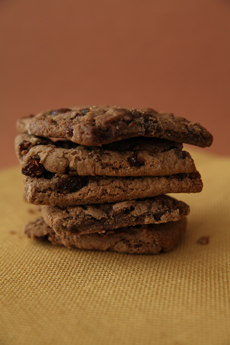TOP PICK OF THE WEEK: Covered Bridge Cookies
|
It began in the summer of 1992, when Carl Goulet began making cookies to sell at a local farmers market in Windsor, Vermont. Then employed as executive chef at a local hospital, Carl had been a pastry chef and baker for most of his working life. He had a part-time venture on the side, Christopher’s Cakes & Pastries. His employer allowed him to rent time in the kitchen after hours.
The cookies expanded in distribution, from the farmers market to local stores, and developed an enthusiastic following. In five years he had outgrown the time and space available at the hospital, and Carl decided to take the plunge to baking full time, investing in a facility and equipment. His Covered Bridge Cookies taste of homemade goodness, using the finest ingredients from Vermont producers: butter from Vermont-based Cabot Creamery, chocolate from Barry Callebaut, a French company with U.S. headquarters in St. Albans, Vermont, and unbleached and unbromated flour from King Arthur Flour in Norwich. Superior ingredients and small batch production techniques that produce delicious, old fashioned goodness—as if you (or your grandmother) had just baked them. |
Hermits: a New England cookie favorite that deserves to be baked more often. Photo by Elvira Kalviste | THE NIBBLE. |
|
|
While we love them all, we have to give a shout-out to the hermit, starting with… |
||
 Old-fashioned goodness in a box. Photo by Elvira Kalviste | THE NIBBLE. |
WHAT ARE HERMITS, AND A BRIEF COOKIE HISTORY English and Dutch immigrants brought cookies to America in the 1600s. The Dutch used the word koekje, while the English primarily referred to cookies as small cakes, seed biscuits, tea cakes, or by specific names, such as jumble (a spiced butter cookie) or macaroon. By the early 1700s, koekje had evolved to cookie or cookey, and was well-entrenched in New York City, then the nation’s capital—a factor that resulted in widespread use of the term. During the 17th, 18th and 19th centuries, most cookies were baked at home as special treats, both because of the amount of labor and the high cost of sugar. Recipes for jumbles, macaroons and gingerbread are found in early cookbooks. Our simple butter cookie recipes are similar to English tea cakes and Scottish shortbread (the term “tea cake” is used to describe that type of cookie in the Southern U.S. as well). During the 19th century, affordable sugar and flour, plus the introduction of chemical raising agents such as bicarbonate of soda (baking soda), led to the development of other types of cookie recipes. Another explosion of cookie recipes took place in the early 1900s, not surprisingly paralleling the introduction of modern ovens with thermostats. Cookbooks yield recipes for cinnamon-accented Snickerdoodles, raisin-filled Hermits, Sand Tarts and many varieties of butter cookies including Southern-style Tea Cakes. |
|
|
Hermits Appear Cookies called hermits appear in New England cookbooks by 1880. Those first Hermits were made with raisins, spices—cinnamon, cloves, and nutmeg—and white sugar. Most recipes that continue in use will evolve. It is a rare for a recipe not to change, whether from creativity of cooks, the availability of new ingredients or changing tastes. According to NewEnglandRecipes.org. Hermits is a classic example: New York bakers replaced white sugar with more flavorful brown sugar. By the 1950s, the Fannie Farmer Cookbook uses white sugar and molasses in place of brown sugar, providing a stronger molasses flavor than with brown sugar alone. A mix of currants and raisins, optional citrons and nuts become Hermit variations. Later versions of Hermits offer the option of dates, figs and dried apricots. Today, the cookies are typically large, chewy molasses cookies with raisins. We wish they were more available in our neck of the woods (or maybe, we should be thankful that they’re not!). Covered Bridge Cookies are $6.99 for a 9-ounce box, about 10 cookies. You can buy them online at VTStuff.com.
|
||



